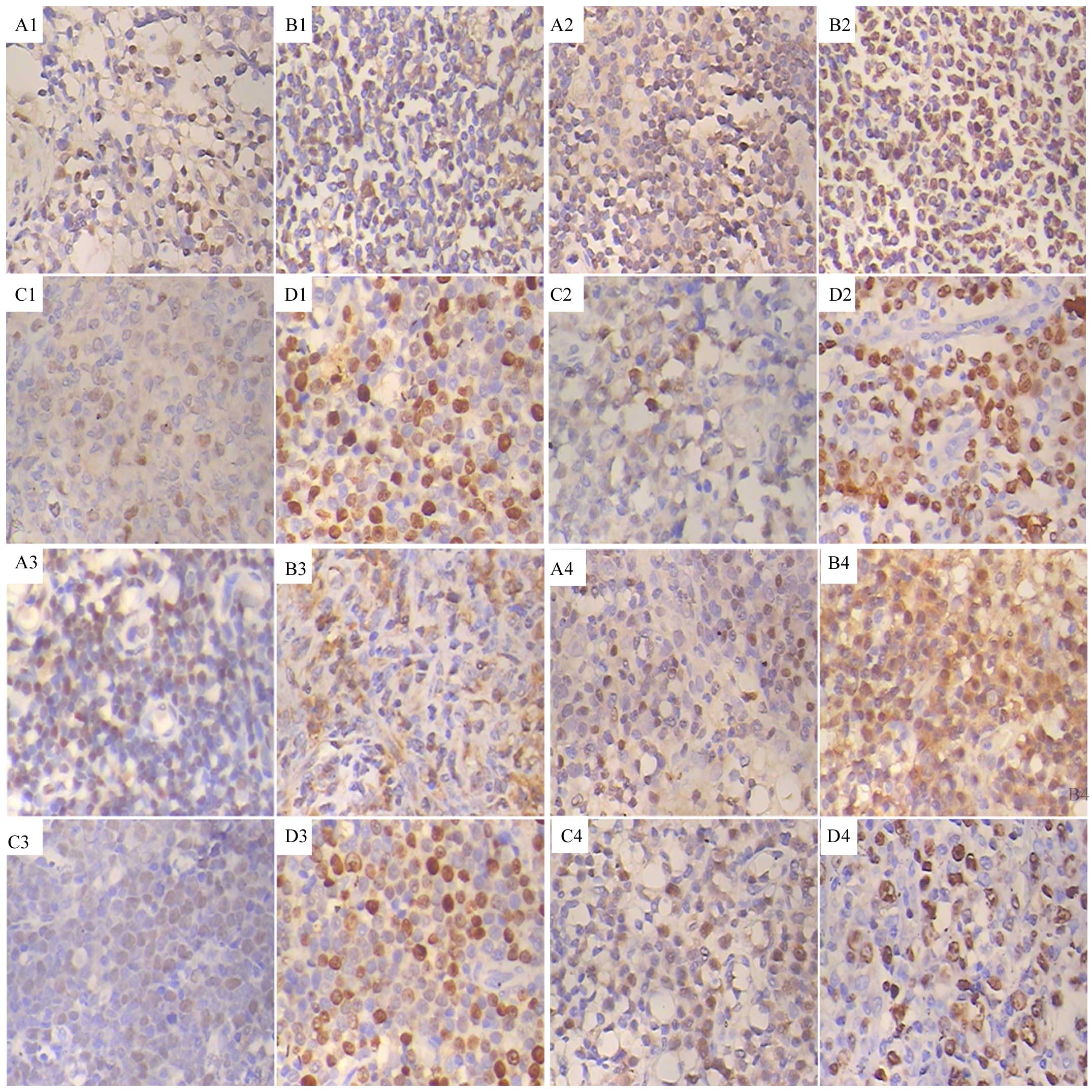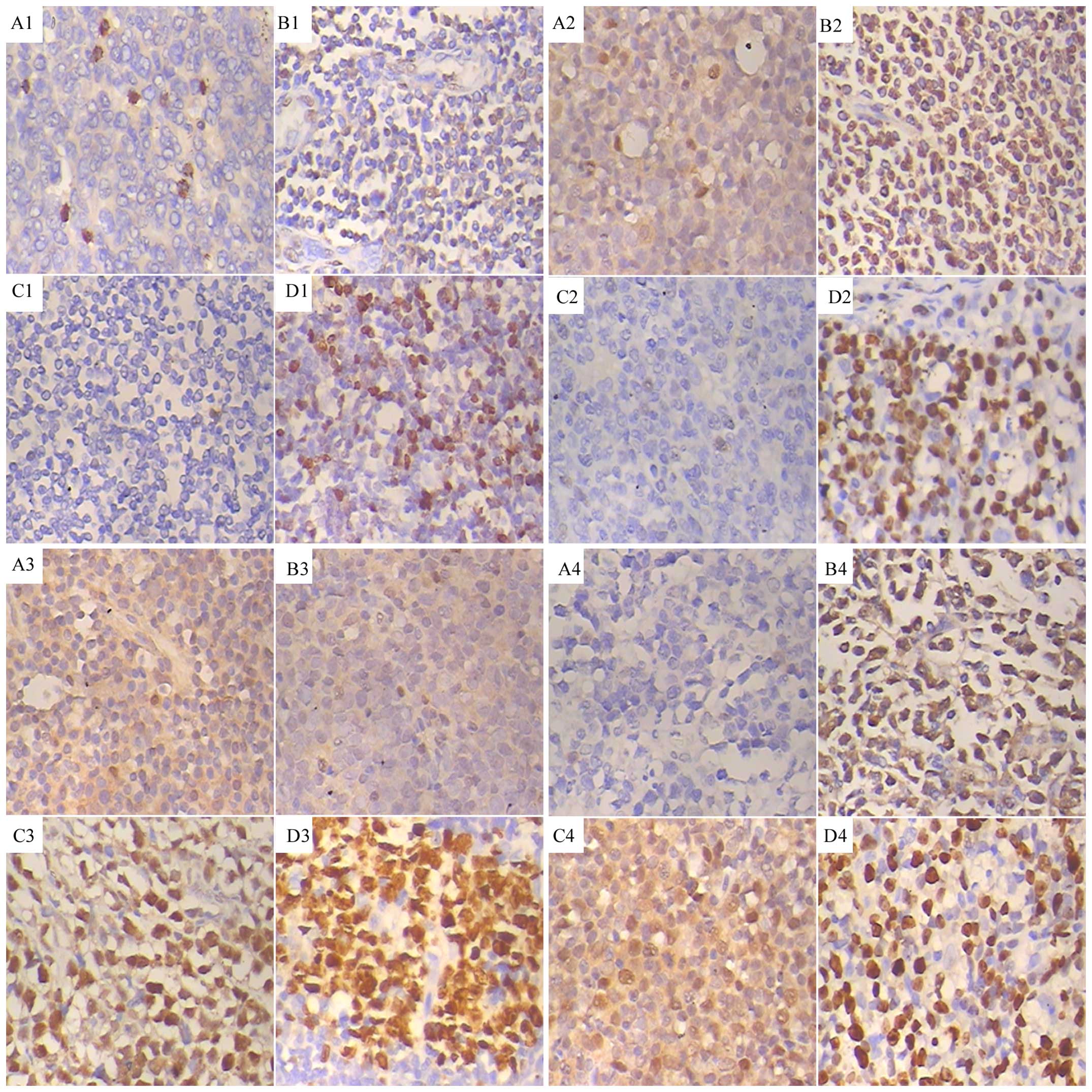|
1
|
Wu M and Zhu J: Changes in nutrition
metabolism of lymphoma after treatment and the nutritional
supports. Acta Academiae Medicinae Sinicae. 36:446–449. 2014.(In
Chinese). PubMed/NCBI
|
|
2
|
Fu ZY, Zhu J, Song YQ, Liu WP, Ji XQ and
Zhan SY: Prognostic analysis of 525 Chinese patients with diffuse
large B-cell lymphoma. J Peking Univ (Health Sci). 46:405–411.
2014.(In Chinese).
|
|
3
|
Zhao H, Bauzon F, Bi E, Yu JJ, Fu H, Lu Z,
Cui J, Jeon H, Zang X, Ye BH and Zhu L: Substituting threonine 187
with alanine in p27Kip1 prevents pituitary tumorigenesis
by two-hit loss of Rb1 and enhances humoral immunity in old age. J
Biol Chem. 290:5797–5809. 2015. View Article : Google Scholar : PubMed/NCBI
|
|
4
|
Ha SY, Lee CH, Chang HK, Chang S, Kwon KY,
Lee EH, Roh MS and Seo B: Differential expression of forkhead box
M1 and its downstream cyclin-dependent kinase inhibitors p27(kip1)
and p21(waf1/cip1) in the diagnosis of pulmonary neuroendocrine
tumours. Histopathology. 60:731–739. View Article : Google Scholar : PubMed/NCBI
|
|
5
|
Sherr CJ and Roberts JM: CDK inhibitors:
Positive and negative regulators of G1-phase progression. Genes
Dev. 13:1501–1512. 1999. View Article : Google Scholar : PubMed/NCBI
|
|
6
|
Dahinden C, Ingold B, Wild P, Boysen G,
Luu VD, Montani M, Kristiansen G, Sulser T, Bühlmann P, Moch H and
Schraml P: Mining tissue microarray data to uncover combinations of
biomarker expression patterns that improve intermediate staging and
grading of clear cell renal cell cancer. Clin Cancer Res. 16:88–98.
2010. View Article : Google Scholar : PubMed/NCBI
|
|
7
|
Claret FX, Hibi M, Dhut S, Toda T and
Karin M: A new group of conserved coactivators that increase the
specificity of AP-1 transcription factors. Nature. 383:453–457.
1996. View
Article : Google Scholar : PubMed/NCBI
|
|
8
|
Chamovitz DA and Segal D: JAB1/CSN5 and
the COP9 signalosome. A complex situation. EMBO Rep. 2:96–101.
2001. View Article : Google Scholar : PubMed/NCBI
|
|
9
|
Schwechheimer C and Deng XW: COP9
signalosome revisited: A novel mediator of protein degradation.
Trends Cell Biol. 11:420–426. 2001. View Article : Google Scholar : PubMed/NCBI
|
|
10
|
Sankar U and Means AR: Gfer is a critical
regulator of HSC proliferation. Cell Cycle. 10:2263–2268. 2011.
View Article : Google Scholar : PubMed/NCBI
|
|
11
|
Porrello E, Rivellini C, Dina G, Triolo D,
Del Carro U, Ungaro D, Panattoni M, Feltri ML, Wrabetz L, Pardi R,
et al: Jab1 regulates Schwann cell proliferation and axonal sorting
through p27. J Exp Med. 211:29–43. 2014. View Article : Google Scholar : PubMed/NCBI
|
|
12
|
Tomoda K, Kubota Y, Arata Y, Mori S, Maeda
M, Tanaka T, Yoshida M, Yoneda-Kato N and Kato JY: The cytoplasmic
shuttling and subsequent degradation of p27Kip1 mediated
by Jab1/CSN5 and the COP9 signalosome complex. J Biol Chem.
277:2302–2310. 2002. View Article : Google Scholar : PubMed/NCBI
|
|
13
|
Li J, Wang Y, Yang C, Wang P, Oelschlager
DK, Zheng Y, Tian DA, Grizzle WE, Buchsbaum DJ and Wan M:
Polyethylene glycosylated curcumin conjugate inhibits pancreatic
cancer cell growth through inactivation of Jab1. Mol Pharmacol.
76:81–90. 2009. View Article : Google Scholar : PubMed/NCBI
|
|
14
|
Sui L, Dong Y, Watanabe Y, Yamaguchi F,
Sugimoto K and Tokuda M: Clinical significance of Skp2 expression,
alone and combined with Jab1 and p27 in epithelial ovarian tumors.
Oncol Rep. 15:765–771. 2006.PubMed/NCBI
|
|
15
|
Kitagawa K, Kotake Y and Kitagawa M:
Ubiquitin-mediated control of oncogene and tumor suppressor gene
products. Cancer Sci. 100:1374–1381. 2009. View Article : Google Scholar : PubMed/NCBI
|
|
16
|
Serres MP, Zlotek-Zlotkiewicz E, Concha C,
Gurian-West M, Daburon V, Roberts JM and Besson A: Cytoplasmic p27
is oncogenic and cooperates with Ras both in vivo and in vitro.
Oncogene. 30:2846–2858. 2011. View Article : Google Scholar : PubMed/NCBI
|
|
17
|
Kim JH, Go HY, Jin DH, Kim HP, Hong MH,
Chung WY, Park JH, Jang JB, Jung H, Shin YC, et al: Inhibition of
the PI3K-Akt/PKB survival pathway enhanced an ethanol extract of
Rhus verniciflua Stokes-induced apoptosis via a mitochondrial
pathway in AGS gastric cancer cell lines. Cancer Lett. 265:197–205.
2008. View Article : Google Scholar : PubMed/NCBI
|
|
18
|
Hung WC, Tseng WL, Shiea J and Chang HC:
Skp2 overexpression increases the expression of MMP-2 and MMP-9 and
invasion of lung cancer cells. Cancer Lett. 288:156–161. 2010.
View Article : Google Scholar : PubMed/NCBI
|
|
19
|
Tosco P, La Terra Maggiore GM, Forni P,
Berrone S, Chiusa L and Garzino-Demo P: Correlation between Skp2
expression and nodal metastasis in stage I and II oral squamous
cell carcinomas. Oral Dis. 17:102–108. 2011. View Article : Google Scholar : PubMed/NCBI
|
|
20
|
Signoretti S, Di Marcotullio L, Richardson
A, Ramaswamy S, Isaac B, Rue M, Monti F, Loda M and Pagano M:
Oncogenic role of the ubiquitin ligase subunit Skp2 in human breast
cancer. J Clin Invest. 110:633–641. 2002. View Article : Google Scholar : PubMed/NCBI
|
|
21
|
Hershko D, Bornstein G, Ben-Izhak O,
Carrano A, Pagano M, Krausz MM and Hershko A: Inverse relation
between levels of p27(Kip1) and of its ubiquitin ligase subunit
Skp2 in colorectal carcinomas. Cancer. 91:1745–1751. 2001.
View Article : Google Scholar : PubMed/NCBI
|
|
22
|
Gstaiger M, Jordan R, Lim M, Catzavelos C,
Mestan J, Slingerland J and Krek W: Skp2 is oncogenic and
overexpressed in human cancers. Proc Natl Acad Sci USA.
98:5043–5048. 2001. View Article : Google Scholar : PubMed/NCBI
|
|
23
|
Di Vizio D, Demichelis F, Simonetti S,
Pettinato G, Terracciano L, Tornillo L, Freeman MR and Insabato L:
Skp2 expression is associated with high risk and elevated Ki67
expression in gastrointestinal stromal tumours. BMC Cancer.
8:1342008. View Article : Google Scholar
|
|
24
|
Rassidakis GZ, Claret FX, Lai R, et al:
Expression of p27(Kip1) and c-Jun activation binding protein 1 are
inversely correlated in systemic an aplastic cell lymphoma. Clin
Cancer Res. 9:1121–1128. 2003.PubMed/NCBI
|
|
25
|
Xie F, Liu H, Zhu YH, Qin YR, Dai Y, Zeng
T, Chen L, Nie C, Tang H, Li Y, et al: Overexpression of GPR39
contributes to malignant development of human esophageal squamous
cell carcinoma. BMC Cancer. 11:862011. View Article : Google Scholar : PubMed/NCBI
|
|
26
|
Ahn J, Hong SA, Lee SE, Kim J, Oh YS, Park
SJ and Chung YJ: Cytoplasmic localization of Jab1 and
p27Kip1 might be associated with invasiveness of
papillary thyroid carcinoma. Endocr J. 56:707–713. 2009. View Article : Google Scholar : PubMed/NCBI
|
|
27
|
Seki R, Ohshima K, Fujisaki T, Uike N,
Kawano F, Gondo H, Makino S, Eto T, Moriuchi Y, Taguchi F, et al:
Prognostic significance of S-phase kinase-associated protein 2 and
p27Kip1 in patients with diffuse large B-cell lymphoma:
Effects of rituximab. Ann Oncol. 21:833–841. 2010. View Article : Google Scholar : PubMed/NCBI
|
|
28
|
Polyak K, Lee MH, Erdjument-Bromage H,
Koff A, Roberts JM, Tempst P and Massagué J: Cloning of
p27Kip1, a cyclin-dependent kinase inhibitor and a
potential mediator of extracellular antimitogenic signals. Cell.
78:59–66. 1994. View Article : Google Scholar : PubMed/NCBI
|
|
29
|
Carrano AC, Eytan E, Hershko A and Pagano
M: SKP2 is required for ubiquitin-mediated degradation of the CDK
inhibitor p27. Nat Cell Biol. 1:193–199. 1999. View Article : Google Scholar : PubMed/NCBI
|
|
30
|
Qi M, Liu D, Zhang S, Hu P and Sang T:
Inhibition of S-phase kinase-associated protein 2-mediated p27
degradation suppresses tumorigenesis and the progression of
hepatocellular carcinoma. Mol Med Rep. 11:3934–3940.
2015.PubMed/NCBI
|
|
31
|
Hashimoto N, Yachida S, Okano K,
Wakabayashi H, Imaida K, Kurokohchi K, Masaki T, Kinoshita H,
Tominaga M, Ajiki T, et al: Immunohistochemically detected
expression of p27(Kip1) and Skp2 predicts survival in patients with
intrahepatic cholangiocarcinomas. Ann Surg Oncol. 16:395–403. 2009.
View Article : Google Scholar : PubMed/NCBI
|
|
32
|
Kouvaraki MA, Korapati AL, Rassidakis GZ,
Tian L, Zhang Q, Chiao P, Ho L, Evans DB and Claret FX: Potential
role of Jun activation domain-binding protein 1 as a negative
regulator of p27Kip1 in pancreatic adenocarcinoma.
Cancer Res. 66:8581–8589. 2006. View Article : Google Scholar : PubMed/NCBI
|
|
33
|
Bech-Otschir D, Kraft R, Huang X, Henklein
P, Kapelari B, Pollmann C and Dubiel W: COP9 signalosome-specific
phosphorylation targets p53 to degradation by the ubiquitin system.
Embo J. 20:1630–1639. 2001. View Article : Google Scholar : PubMed/NCBI
|
|
34
|
Naumann M, Bech-Otschir D, Huang X,
Ferrell K and Dubiel W: COP9 signalosome-directed c-Jun
activation/stabilization is independent of JNK. J Biol Chem.
274:35297–35300. 1999. View Article : Google Scholar : PubMed/NCBI
|
|
35
|
Pan Y, Zhang Q, Tian L, Wang X, Fan X,
Zhang H, Claret FX and Yang H: Jab1/CSN5 negatively regulates p27
and plays a role in the pathogenesis of nasopharyngeal carcinoma.
Cancer Res. 72:1890–1900. 2012. View Article : Google Scholar : PubMed/NCBI
|
|
36
|
Lwin T, Hazlehurst LA, Dessureault S, Lai
R, Bai W, Sotomayor E, Moscinski LC, Dalton WS and Tao J: Cell
adhesion induces p27Kip1-associated cell-cycle arrest
through down-regulation of the SCFSkp2 ubiquitin ligase pathway in
mantle-cell and other non-Hodgkin B-cell lymphomas. Blood.
110:1631–1638. 2007. View Article : Google Scholar : PubMed/NCBI
|
|
37
|
Dowen SE, Scott A, Mukherjee G and Stanley
MA: Overexpression of Skp2 in carcinoma of the cervix does not
correlate inversely with p27 expression. Int J Cancer. 105:326–330.
2003. View Article : Google Scholar : PubMed/NCBI
|


















